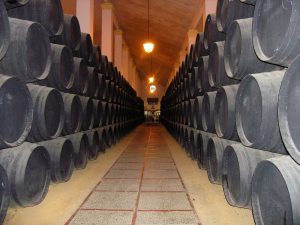
Grape Destinations: A Sherry Love Affair
It all started after parking the car under one of the orange trees in the historical city center of
Jerez de la Frontera, in southwestern Spain. I’ve always liked wine but I hardly knew about
sherry. Of course, sometimes I had a glass of dry Fino sherry as aperitif, but nothing else.
I already knew, while getting out of the car and smelling the particular sherry flavor, this would
be a great discovery!

Orange Trees | Photo: Helena Stael
My First Sips
The first big cellar I ran into was González-Byass. I could smell the fermentation through the medieval castle-like walls and it drew my attention immediately. However, I thought it would be too touristy and not authentic enough so I decided to walk by. I became more aware of the town and saw there were many more cellars. I decided to enter Lustau. This opened a new world to me! Here they explained to me exactly how sherry is made and aged. First there is the miracle of the flor, a natural yeast layer that covers the wine and prevents it from oxidation. However, sometimes it goes wrong and the yeast doesn’t do its job: the wine oxidizes and turns into amontillado. The winemaker knows which wine won’t be suited for a dry sherry and decides to top it with alcohol from the beginning. This turns the wine after aging in an amber colored oloroso.
RELATED: A Taste of Spain on Windstar
The Sherry System

Barrels of Sherry | Photo: Helena Stael
I couldn’t believe my eyes at the sight of the barrels piled up in three layers or more. Already fascinated by this complex, miraculous sherry, I tried to understand the solera and criadera ageing system. After having tasted the whole range, from fino to the sweet Pedro Ximenez, and having walked in the Palomino vineyards, I fell madly in love with this wine region. I can’t get enough of listening to the passionate winemakers and learning about their wines. Jerez de la Frontera, a small town with history, to which I will always return.
-Helena Staels









